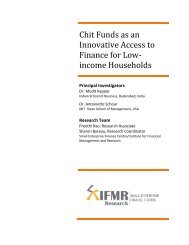Government of India Volume I: Analysis and Recommendations
Government of India Volume I: Analysis and Recommendations
Government of India Volume I: Analysis and Recommendations
Create successful ePaper yourself
Turn your PDF publications into a flip-book with our unique Google optimized e-Paper software.
CHAPTER 2<br />
The tasks <strong>of</strong> financial law<br />
The Commission has envisaged certain key components <strong>of</strong> the financial legal framework.<br />
Each <strong>of</strong> these components is guided by a clear underst<strong>and</strong>ing <strong>of</strong> market failures. Regulation<br />
is not an end in itself; it exists in order to address market failures. The Commission<br />
strongly feels that laws must be defined in terms <strong>of</strong> their economic purpose, rather than<br />
in terms <strong>of</strong> the powers conferred upon regulatory agencies or in terms <strong>of</strong> the entities who<br />
are affected by the law. This clarity on objectives is essential for obtaining accountability<br />
in regulation. If an agency is given the objective <strong>of</strong> ‘regulation’, then accountability is lost,<br />
because the agency will always be able to demonstrate that it has, indeed, regulated.<br />
From this perspective, the tasks <strong>of</strong> financial law can be envisioned as the following<br />
nine components:<br />
1. Consumer protection: A prime motivation <strong>of</strong> all financial regulation is to protect consumers. The<br />
relationship between financial firms <strong>and</strong> their customers is one where, many times, the outcomes<br />
may harm customers. These problems are not sporadic or accidental; but are <strong>of</strong>ten rooted in<br />
basic problems <strong>of</strong> information <strong>and</strong> incentives <strong>and</strong> will not be alleviated through financial literacy<br />
campaigns. The central purpose <strong>of</strong> financial regulation is to intervene in the relationship between<br />
financial firms <strong>and</strong> their customers, <strong>and</strong> address market failures. This requires a comprehensive<br />
consumer protection framework that covers both the problem <strong>of</strong> prevention (interventions that<br />
induce financial firms towards fair play) <strong>and</strong> cure (addressing consumer grievances).<br />
2. Micro-prudential regulation: One element <strong>of</strong> protecting consumers is to constrain financial firms<br />
to take lower risk, so as to improve the extent to which promises by a financial firm to a consumer<br />
are upheld. This is the task <strong>of</strong> micro-prudential regulation. In addition to being motivated by<br />
consumer protection, high quality micro-prudential regulation also reduces systemic risk. This<br />
calls for a comprehensive micro-prudential framework.<br />
3. Resolution: The best efforts <strong>of</strong> micro-prudential regulation will reduce, but not eliminate, the failure<br />
<strong>of</strong> financial firms. When such episodes arise, a specialised resolution capability is required<br />
to ensure graceful winding up <strong>of</strong> a financial firm that has become unviable, <strong>and</strong> transition the<br />
customers <strong>of</strong> the erstwhile firm. Under a formal arrangement such as this, a key difference that<br />
will be induced by a resolution corporation will be reduced burden on tax payer resources by<br />
failing financial firms. When a financial firm is healthy, it would face micro-prudential regulation,<br />
while the resolution corporation would lie in the background. When the firm approaches failure,<br />
it would increasingly face the resolution corporation. This requires the legal framework to create<br />
a resolution corporation <strong>and</strong> set it in motion.<br />
4. Capital controls: <strong>India</strong> now has an open current account, but many capital account restrictions<br />
remain. The Commission agreed that the timing <strong>and</strong> sequencing <strong>of</strong> capital account liberalisation<br />
should be chosen by policy makers in the future. The drafting <strong>of</strong> law needs to establish a sound<br />
legal foundation for capital controls, with a focus on objectives <strong>and</strong> accountability in regulationmaking,<br />
<strong>and</strong> an emphasis on the rule <strong>of</strong> law. The regulations governing inward flows should<br />
FINANCIAL SECTOR LEGISLATIVE REFORMS COMMISSION 11



